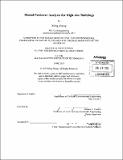Modal pushover analysis for high-rise buildings
Author(s)
Zheng, Ming, M. Eng. Massachusetts Institute of Technology
DownloadFull printable version (6.578Mb)
Other Contributors
Massachusetts Institute of Technology. Department of Civil and Environmental Engineering.
Advisor
Jerome J. Connor.
Terms of use
Metadata
Show full item recordAbstract
Pushover analysis is a nonlinear static analysis tool widely used in practice to predict and evaluate seismic performance of structures. Since only the fundamental mode is considered and the inelastic theorem is imperfect for the conventional pushover analysis, a modified Modal Pushover Analysis (MPA) is proposed by researchers. In this thesis, the theories of dynamics for single-degree-of-freedom (SDOF) and multiple-degree-of-freedom (MDOF) are introduced, including elastic analysis and inelastic analysis. The procedures and equations for time history analysis, modal analysis, pushover analysis and modal pushover analysis are discussed in detail. Then an 8-story height model and a 16-story height model are established for analysis. The pushover analysis is conducted for each equivalent SDOF system, and by combination of the distribution of 1 mode, 2 modes and 3 modes, the responses of modal pushover analysis are obtained. The results of pushover analysis and modal pushover analysis are compared with those of time history analysis. The results of the analysis show that the conventional pushover analysis is mostly limited to low- and medium-rise structures in which only the first mode is considered and where the mode shape is constant. The modal pushover analysis is shown to have a superior accuracy in evaluation of seismic demands for higher buildings, especially for story drift ratios and column shears. With this in mind, some design recommendations and areas of future work are proposed in the conclusion.
Description
Thesis (M. Eng.)--Massachusetts Institute of Technology, Department of Civil and Environmental Engineering, 2013. Cataloged from PDF version of thesis. Includes bibliographical references (pages 50).
Date issued
2013Department
Massachusetts Institute of Technology. Department of Civil and Environmental EngineeringPublisher
Massachusetts Institute of Technology
Keywords
Civil and Environmental Engineering.